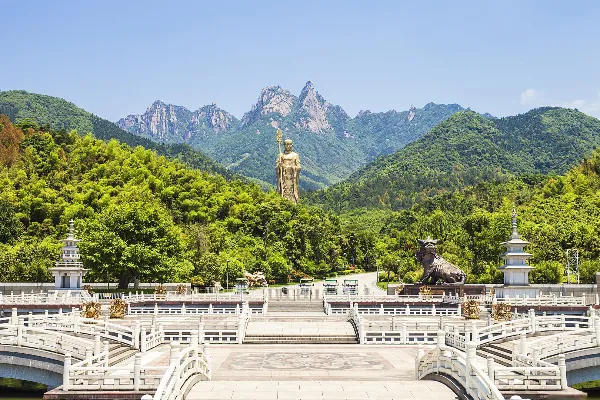
Located in Qingyang County, Chizhou City, Anhui Province, Mount Jiuhua is one of China's Four Sacred Buddhist Mountains and a National 5A-level Scenic Spot. Covering 120 square kilometers, its highest peak Shiwang Feng reaches 1,342m. With 99 active temples housing 15,000 Buddha statues and 2,000 cultural relics, it's renowned as "The Most Sacred Incense Burner". The area combines Buddhist heritage, granite landforms, and sea-of-clouds vistas, earning the title "First Mountain Southeast of Yangtze".
History & Culture
Buddhist activities date back to Eastern Jin Dynasty. In Tang Dynasty, Korean prince Kim Kyo-gak practiced asceticism here for 75 years, later recognized as an incarnation of Ksitigarbha Bodhisattva. The Ming-Qing period saw over 1,000 temples "scattered in clouds". Imperial plaques and 500+ literary works remain. Huacheng Temple (Tang Dynasty) preserves palm-leaf manuscripts and blood-written sutras.
Main Attractions
Tiantai Peak
The summit at 1,342m marks Ksitigarbha's enlightenment site. "True Summit" inscription overlooks Yangtze River on clear days. Pilgrimage route passes Scripture-Worship Platform and Guanyin Peak.
Incarnation Hall
Enshrines the gold-leafed mummy of Ming Dynasty monk Wuxia (died age 126). Houses Kangxi Emperor's inscribed plaque "Sacred Jiuhua", a major Buddhist relic.
Centenarian Palace
Ming-era cliffside complex named after monk Haiyu's mummy (died age 110). Unique beamless architecture with five-tiered corridors, offering panoramic views of Jiuhua Street.
Flower Terrace
Core natural zone featuring bizarre rock formations. Spring brings rhododendron blooms, while cliffside trails pass Buddha Rock and Immortal's Boot.
Cuisine
Buddhist Vegetarian Cuisine
Millennium-old monastic tradition using tofu, mushrooms, and vegetables. Signature "Arhat's Feast" combines 18 ingredients, while "Vegetarian Ham" mimics meat texture.
Lingyang Hotpot
Local earthenware stew with black pork, sweet potato noodles, and dried beans. Slow-cooked 8 hours over charcoal, ideal winter nourishment.
Jiuhua Buddha Tea
Tang Dynasty tribute tea grown above 600m. Thick leaves brew golden-edged liquor with orchid fragrance, traditionally offered to Buddha.
Tickets
Peak season (Jan-Nov): ¥160; Off-season: ¥140. Cable cars: Centenarian Palace ¥55/one-way, Tiantai ¥160/round-trip. Half-price for seniors(60+)/students, free under 1.2m. Real-name booking required, available 3 days in advance.
Suggested Routes
1-day: Jiuhua Street→Huacheng Temple→Incarnation Hall→Centenarian Palace→Qiyuan Temple. 2-day: D1 temple cluster, D2 sunrise at Tiantai→Phoenix Pine→Ancient Worship Platform. 3-day for Flower Terrace and backcountry hiking.
Transportation
- Air: Chizhou Jiuhuashan Airport (30km)
- HSR: Chizhou/Tongling North Station→shuttle bus
- Highway: G3 Beijing-Taipei Expressway exit
- Shuttle: ¥50 scenic area pass
Must-See Spots
- Tiantai Peak: Ksitigarbha's enlightenment site
- Incarnation Hall: Exceptional mummy preservation
- Flower Terrace: Granite pinnacles
- Huacheng Temple: Founding monastery
Travel Tips
- Join morning sutra chanting
- Prepare small bills for donations
- Wear non-slip flat shoes
- May for flowers, September for clouds
- Observe Buddhist etiquette
Precautions
- No photography in temple halls
- Remove shoes at certain shrines
- Avoid touching ritual objects
- Prepare for sudden weather changes
- Do not provoke wild monkeys
